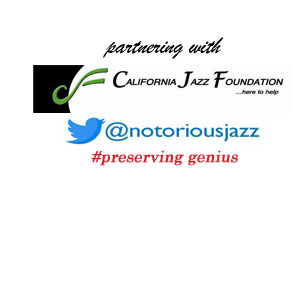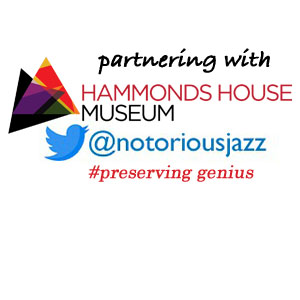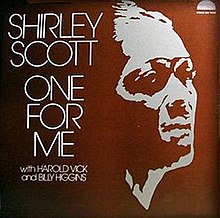
The Quarantined Jazz Voyager
As life moves forward and I remain steadfast in social distancing, I was reminded of an album produced by hard bop, soul~jazz organist Shirley Scott. This was a very personal album for the artist as it is filled with the music she always wanted to create but the demands of her vibrant career always overshadowed. With her friend and executive producer Maxine Gordon, they produced and recorded the session that became the album titled One For Me. This album was made to please no one but the artist herself.
Given two monikers, The Queen Of The Organ and Little Miss Half-Steps, the latter given to her by saxophonist George Coleman, this Philadelphian raised the funds to make the record, she had complete control over her masters and with her dream band, recorded in November 1974 at Blue Rock Studios in New York City. The album was released on the Strata~East label in Januray 1975. It has been re-released in 2020 on Arc Records.
Track List | 41:54- What Makes Harold Sing? ~ 8:53
- Keep on Movin’ On (Harold Vick) ~ 9:52
- Big George ~ 5:22
- Don’t Look Back (Vick) ~ 8:56
- Do You Know a Good Thing When You See One? ~ 8:51
- Shirley Scott – organ, mellotron
- Harold Vick – tenor saxophone
- Billy Higgins – drums
- Jimmy Hopps – cowbell, triangle (track 2)
More Posts: adventure,album,club,genius,jazz,museum,music,organ,preserving,restaurant,travel
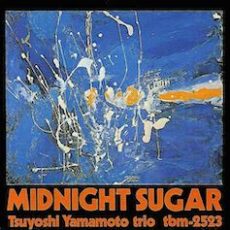
Requisites
Midnight Sugar ~ Tsuyoshi Yamamoto Trio | By Eddie Carter
This morning’s choice from the library is one of my absolute favorites because each time I hear it, I’m transported back to one of my happiest memories as a young adult. If any of you lived in Cleveland, Ohio during the seventies and eighties, Audio Craft at 3915 Carnegie Avenue was the place to go if you wanted to purchase a quality entry-level, mid-level, or high-end audio system. My uncle Bob Franks was the manager there for many years and I got to help him on Monday and Thursday evenings, and each Saturday. He was instrumental in teaching me about excellent audio equipment, helping me put together my first system, and introducing me to The Tsuyoshi Yamamoto Trio.
Midnight Sugar (Three Blind Mice TBM-23) is the group’s 1974 debut for the Japanese jazz label and has long been a favorite to demonstrate high-end audio equipment at audio shows and audio salons worldwide. It’s also become a collector’s item, a mint original LP or the 1977, 1979, and 1982 Stereo reissues can cost a few hundred dollars. Joining the pianist are two giants in their own right, Isoo Fukui on bass and Tetsujiro Obara on drums. My copy used for this report is the 1977 Japanese Stereo reissue (Three Blind Mice TBM-2523) and LP collectors take note. Only the 1977, 1979 (TBM(P)-2523) and 1982 (Trio Records – Three Blind Mice PAP-2006) reissues list the group’s name as Tsuyoshi Yamamoto Trio. All other LP reissues and the original release show the pianist’s last name first.
Midnight Sugar is a slow tempo blues beginning Side One with a brief bowed bass introduction by Isoo before Yamamoto takes over on the melody. Tsuyoshi is the only soloist and is at his best on a lengthy interpretation that’s sublimely soulful and one of the highlights on the album, thanks to the rhythmic harmony provided by his colleagues. I’m A Fool To Want You was written in 1951 by Frank Sinatra, Jack Wolf, and Joel Herron. Sinatra recorded the song for Columbia Records, making it a hit. It opens with a graceful introduction and wistful delivery of the melody. The pace moves to midtempo for Yamamoto’s solo performance and he responds with a mesmerizing display and emotional depth preceding the closing chorus ending with fingertip delicacy.
The Nearness of You starts Side Two and was written in 1937 by Hoagy Carmichael and Ned Washington. It became a hit for Ray Eberle who recorded it with The Glenn Miller Orchestra in 1940. The trio dresses up this timeless evergreen with a blissful theme treatment and a sentimental swing on the song’s only interpretation by Yamamoto drawing the listener into this beautiful standard at a leisurely pace. It Could Happen To You is by Jimmy Van Heusen and Johnny Burke, this popular song was written in 1943 and was first recorded by vocalist Jo Stafford with the Paul Weston Orchestra. Its first film appearance was in the 1944 musical comedy And The Angels Sing. The trio’s interaction is stunning on the dreamy melody. Tsuyoshi’s reading is skillfully constructed with tender lyricism on one of the most beautiful ballads ever written.
The album closes with Yamamoto’s Sweet Georgia Blues, an uptempo original sharing some similarities with the 1925 jazz and pop classic, Sweet Georgia Brown by Ben Bernie, Ken Casey, and Maceo Pinkard. It opens with a vivacious theme by the trio, then a brief comment preceding Obara giving a short workout of explosive fireworks. Tsuyoshi wraps up the album with a few final remarks of fun leading to the lively closing chorus.
Three Blind Mice began in 1970 with the premise of showcasing emerging jazz artists. The label produced one-hundred thirty albums over thirty years and was known for their outstanding sound. TBM also was instrumental in the development of Japanese jazz. Many of the stars from Japan now known around the world recorded their debut albums on the label. The album was produced by Takeshi Fujii who ran TBM for many years and recorded by Yoshihiko Kannari, the distinguished Japanese engineer who worked for TBM at the time, and now runs his own organization, Studio Lion since 2000.
The sound on Midnight Sugar is spectacular and a perfect choice to demonstrate any mid-level or high-end audio system. Your sweet spot is right in the studio with the musicians because of the incredible lifelike detail coming from the piano, bass, and drums. Tsuyoshi Yamamoto has an incredible discography of music, is still performing today and all of his albums on Three Blind Mice are worth occupying a spot in your library. If you’re looking for a jazz trio album for the library or are a fan of piano jazz specifically, I happily submit for your approval, Midnight Sugar by Tsuyoshi Yamamoto Trio. An album that’s quite a value for the music, sound quality, and a title that’ll provide its owner many hours of listening pleasure.
~ I’m A Fool To Want You (Columbia 39425); It Could Happen To You (Capitol Records 158)
~ The Nearness of You (Bluebird B-10745) – Source: Discogs.com
~ It Could Happen To You, The Nearness of You – Source: JazzStandards.com
~ I’m A Fool To Want You, Sweet Georgia Brown, Three Blind Mice – Source: Wikipedia.org
© 2021 by Edward Thomas Carter
More Posts: choice,classic,collectible,collector,history,instrumental,jazz,music,piano
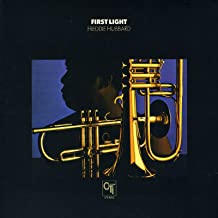
The Quarantined Jazz Voyager
With a surge in Covid cases after Thanksgiving travel, I am doubling down on maintaining my social distancing and wearing my mask when I have to go out, otherwise, I remain in quarantine. From the shelves of my jazz collection, I am placing on the turntable the 1971 recording of First Light by trumpeter Freddie Hubbard, his third release on Creed Taylor’s CTI label.
The string arrangements are by conductor Don Sebesky and features performances by Herbie Hancock, Eric Gale, George Benson, Ron Carter, Jack DeJohnette, Airto Moreira, and Richard Wyands. The album is part of a trilogy including his two previous records at the time, Red Clay and Straight Life. First Light won the 1972 Grammy Award for Best Jazz Performance by a Group.
TRACKS | 42:55- First Light (Hubbard) ~ 11:05
- Uncle Albert/Admiral Halsey (McCartney, McCartney) ~ 8:17
- Moment to Moment (Mancini, Mercer) ~ 5:43
- Yesterday’s Dreams (Martin, Sebesky) ~ 3:55
- Lonely Town [from On the Town] (Bernstein, Comden, Green) ~ 7:00
- Fantasy in D” (Walton) ~ 6:55
- Freddie Hubbard – trumpet, flugelhorn
- Jack DeJohnette – drums
- Ron Carter – bass
- Richard Wyands – piano
- George Benson – guitar
- Airto Moreira – percussion
- Herbie Hancock – Fender Rhodes piano
- Phil Kraus – vibraphone
- Hubert Laws – flute
- Wally Kane – flute, bassoon
- George Marge – flute, clarinet
- Romeo Penque – flute, English horn, oboe, clarinet
- Jane Taylor – bassoon
- Ray Alonge – French horn
- James Buffington – French horn
- Margaret Ross – harp
- David Nadien – violin
- Paul Gershman – violin
- Emanuel Green – violin
- Harold Kohon – violin
- Joe Malin – violin
- Gene Orloff – violin
- Matthew Raimondi – violin
- Tosha Samaroff – violin
- Irving Spice – violin
- Alfred Brown – viola
- Emanuel Vardi – viola
- Charles McCracken – cello
- George Ricci – cello
You all know I will be back flying around the globe just as soon as the world becomes safe again from this pandemic. In the meantime, stay safe and healthy.
More Posts: choice,classic,collectible,collector,history,instrumental,jazz,music,trumpet

Daily Dose Of Jazz…
Jane Monheit was born November 3, 1977 and grew up in Oakdale, New York on Long Island. Her father played banjo and guitar, her mother sang and played records by vocalists beginning with Ella Fitzgerald. At an early age, she was drawn to jazz and Broadway musicals.
She began singing professionally while attending Connetquot High School in Bohemia, New York. She attended the Usdan Summer Camp for the Arts and at the Manhattan School of Music, studying voice under Peter Eldridge, and graduating in 1999.
She was runner-up to Teri Thornton in the 1998 vocal competition at the Thelonious Monk Institute of Jazz, in Washington, DC. The next year when she was 22, she recorded her debut album, Never Never Land that was released the following year. Jane recorded many songs from the Great American Songbook and after recording for five labels, she started her own, Emerald City Records. The label’s inaugural release was The Songbook Sessions in 2016, an homage to Fitzgerald.
Monheit’s vocals were featured in the 2010 film Never Let Me Go for the titular song, written by Luther Dixon, and credited to the fictional Judy Bridgewater.
She has released eleven albums as a leader and has been a guest vocalist on eight albums recorded by David Benoit, Terence Blanchard, Les Brown, Tom Harrell, Harold Mabern, Mark O’Connor, Frank Vignola, and Joe Ascione. Vocalist Jane Monheit continues to perform and record.
More Posts: bandleader,history,instrumental,jazz,music,vocal
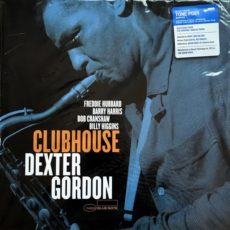
Requisites
Clubhouse ~ Dexter Gordon | By Eddie Carter
Any opportunity I get to discuss an album by tenor saxophonist Dexter Gordon is always welcome, so I begin September with a recent addition to the library. Clubhouse (Blue Note Classic LT-989) is a date from 1965 that also produced the album, Gettin’ Around, but was shelved until 1979. The ensemble is a stellar one, Freddie Hubbard on trumpet; Barry Harris on piano; Bob Cranshaw on bass and Billy Higgins on drums. My copy used in this report is the 2019 Blue Note Tone Poet Series Stereo Audiophile reissue (Blue Note B0029356-01 – LT-989).
The quintet gets into some Hanky Panky to begin Side One with a melody march. Dexter swings with a bluesy beat on the opening statement. Freddie takes over for a neatly paced reading next. Barry ices the closer with a laid-back attitude into a marvelous finale. I’m A Fool To Want You is from 1951 by Frank Sinatra, Jack Wolf, and Joel Herron. Sinatra co-wrote the lyrics and recorded it for Columbia that year. Gordon expresses personal thoughts of lyrical reflection on the opening chorus and first solo. Hubbard and Harris also arouse tender emotions on two beautiful readings before the luxurious coda.
Devilette is by bassist Ben Tucker and was first heard on the 1971 live album, The Montmartre Collection, Vol. 1. This midtempo swinger makes a wonderful vehicle for the quintet to swing easily on the melody. Dexter struts smoothly into the first solo, then Freddie speaks proficiently next. Barry closes with an articulate, passionate interpretation ahead of the conclusion. The quintet convenes inside Gordon’s Clubhouse to start Side Two for a laid-back meeting offering everyone a solo opportunity. Harris gives a charming introduction blossoming into the ensemble’s collective theme. Gordon starts with a soulfully, mellow statement, then Hubbard offers some rhythmically incisive ideas. Harris follows for a melodic mix of grace and fire that’s especially effective. Bob has a definitive moment on the fourth interpretation and Billy wraps things up in a brief exchange with the front line. Jodi is a thoughtfully provocative tribute to Gordon’s wife at the time. Dexter opens with a perfect evocation of love on the melody and first solo. Freddie creates a concise mood of ecstasy next, and Barry adds a touch of sweet lyricism preceding the romantic ending.
The album ends with a tune by guitarist Rudy Stevenson that I first heard on the 1961 album Two Feet In The Gutter, Lady Iris B. The solo order is Gordon, Hubbard, Harris, Cranshaw, and their messages are full of joy and happiness into an immensely satisfying ending that’s positive and upbeat. Clubhouse was produced by Joe Harley of Music Matters Jazz and mastered by Kevin Gray of Cohearent Audio from Rudy Van Gelder’s original analog master tape utilizing 180-gram audiophile vinyl.
The Blue Note Tone Poet Series reissues include high-definition gatefold photos that are worthy of wall art and superb packaging of the covers. The music is simply amazing, and the sound is reference quality with a breathtaking soundstage that’s thrilling, to say the least. Dexter Gordon was a jazz master in every sense as a bandleader, composer, and tenor saxophonist. Clubhouse is nearly forty-minutes of exceptional jazz and an excellent choice for Blue Note to rescue from oblivion for any fan who loves Hard-Bop that you shouldn’t miss on your next vinyl hunt!
~ Gettin’ Around (Blue Note BLP 4204/BST 84204); I’m A Fool To Want You (Columbia 39425); The Montmartre Collection, Vol. 1 (Black Lion BL-108); Two Feet In The Gutter (Epic LA 16021/BA 17021) – Source: Discogs.com
~ I’m A Fool To Want You – Source: Wikipedia.org
© 2020 by Edward Thomas Carter
More Posts: choice,classic,collectible,collector,history,instrumental,jazz,music,saxophone




